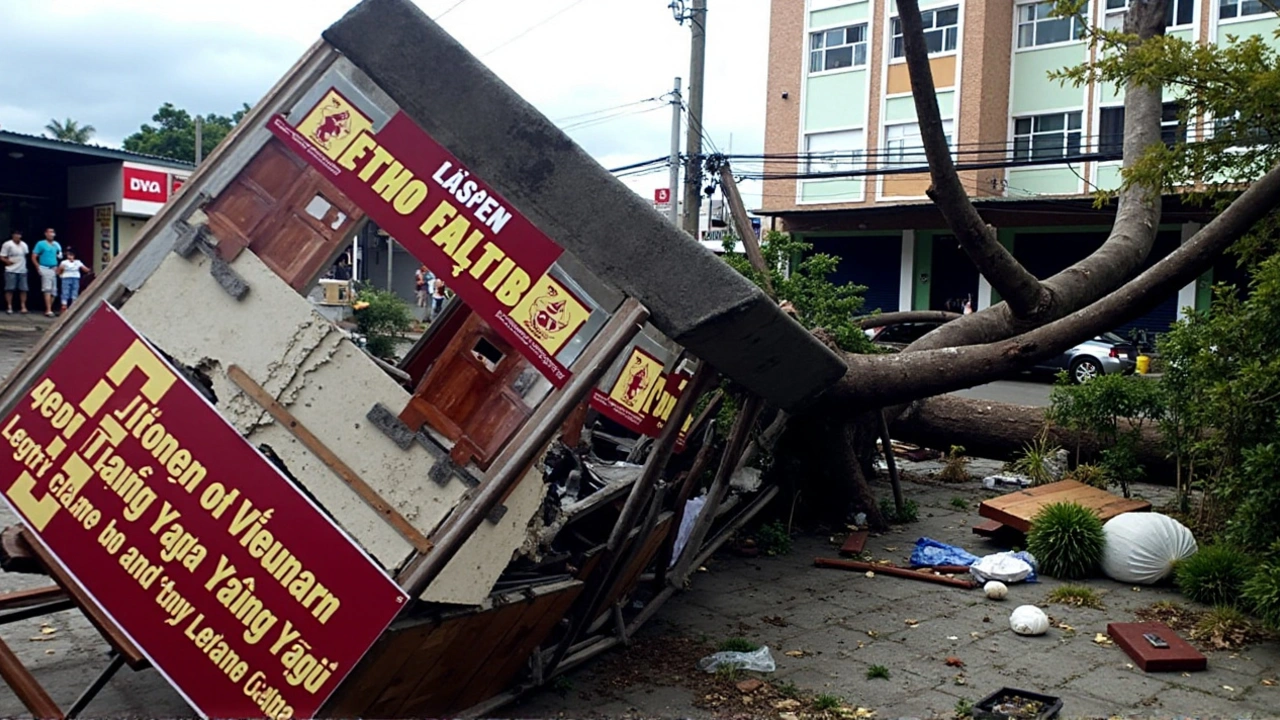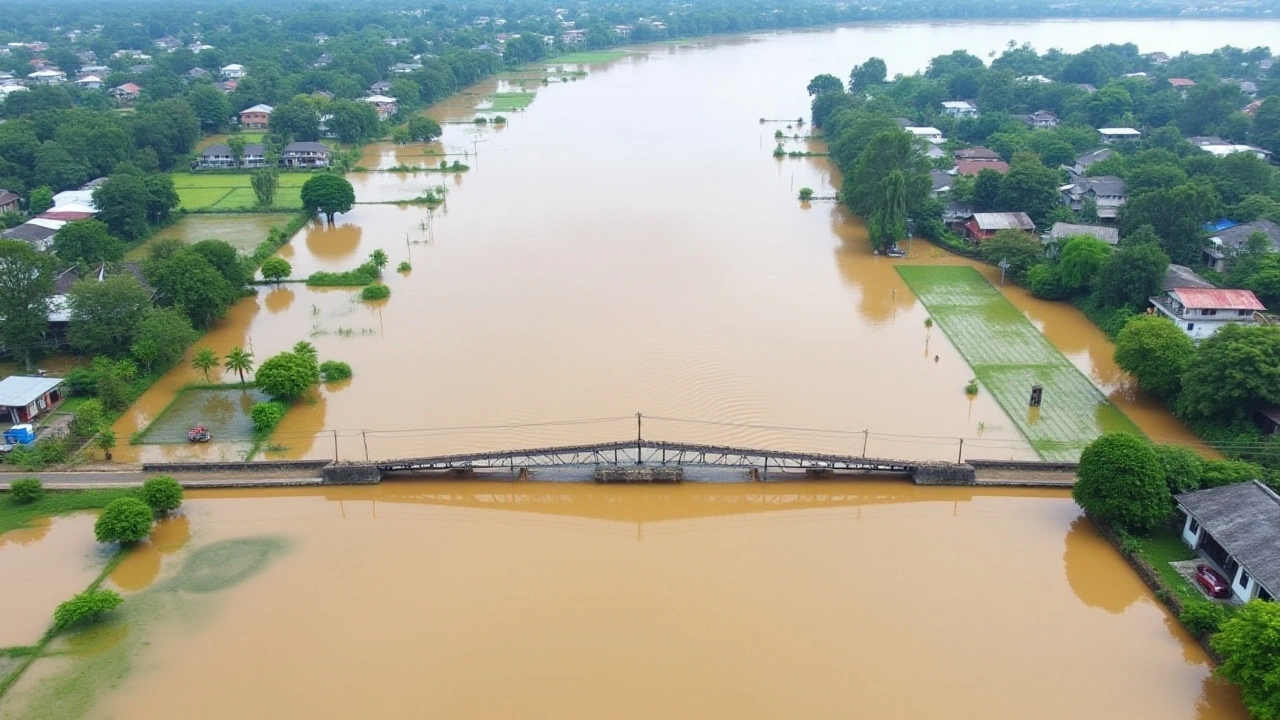Typhoon Yagi's Trail of Devastation in Vietnam: A Closer Look
In recent events, Typhoon Yagi has wreaked havoc across Vietnam, leaving a staggering death toll in its wake. A recent update from Vietnam’s state media reports that the number of casualties has increased to 59. The country's northern regions bore the brunt of the devastation, with landslides and flash floods accounting for 44 out of the total fatalities. These natural calamities have not only taken lives but have also inflicted severe infrastructural damage, including the collapse of a vital bridge in Phong Chau.
The relentless fury of Typhoon Yagi has left communities devastated, with many families mourning the loss of their loved ones. The landslides, triggered by the heavy rainfall, have buried homes and cut off remote villages, making rescue operations exceedingly challenging. Moreover, the flash floods have swept away livestock, crops, and essential belongings, leaving residents in dire need of assistance.

Destruction of Infrastructure
One of the most significant infrastructural devastations occurred in Phong Chau, where a crucial bridge collapsed under the pressure of the torrential downpour. The bridge's collapse has disrupted transportation and communication, isolating communities and hampering relief efforts. Roads have also been rendered impassable due to the debris and fallen trees, further complicating the situation for rescue teams striving to reach the affected areas.
Public services have been strained, with power outages and water supply disruptions adding to the chaos. Schools, hospitals, and government buildings have sustained varying degrees of damage, impacting the daily lives of residents. The destruction of essential infrastructure underscores the urgent need for extensive recovery and rebuilding initiatives to restore stability in the affected regions.

Humanitarian Response and Challenges
As the death toll rises, the urgency for humanitarian aid becomes ever more critical. Local authorities, along with international aid organizations, have mobilized to provide immediate relief to the affected communities. Emergency shelters have been set up, offering temporary refuge to those displaced by the storm's wrath. Distribution of food, water, and medical supplies is underway, but the scale of the disaster presents substantial logistical challenges.
The terrain's rugged nature and ongoing adverse weather conditions have impeded the swift delivery of aid. Helicopter drops have been employed in the most inaccessible areas, but resources are stretched thin. Additionally, the psychological toll on survivors, many of whom have lost family members and homes, cannot be overlooked. Mental health support and counseling services are being deployed to assist those grappling with trauma and grief.

Environmental Impact and Future Preparations
Typhoon Yagi has also inflicted significant environmental damage, with landscapes scarred by landslides and floodwaters. The agricultural sector, a backbone of Vietnam's local economy, has been hit hard, with fields inundated and crops destroyed. This loss not only affects the food supply but also the livelihoods of countless farmers who rely on the land for their income.
In the wake of such a disaster, the importance of preparedness and climate resilience becomes evident. Vietnam, susceptible to typhoons and extreme weather, must prioritize enhancing its disaster management infrastructure. This includes improved early warning systems, robust evacuation plans, and the fortification of essential infrastructure to withstand future calamities.
Conclusion
The tragic increase in the death toll from Typhoon Yagi highlights the immense human and infrastructural toll of natural disasters. As Vietnam grapples with the aftermath, the need for immediate and sustained relief efforts is paramount. The devastation underscores the importance of preparedness and resilience in the face of nature's unpredictable fury. The global community's support and solidarity will be crucial in aiding Vietnam's recovery and rebuilding process.






18 Comments
Gabriel Clark
September 11, 2024 AT 08:57 AMThis is heartbreaking. The scale of loss is staggering-59 lives lost, entire villages cut off, bridges gone. My heart goes out to the families and first responders. Hope international aid can get through soon.
Elizabeth Price
September 13, 2024 AT 08:02 AMThe death toll is 59? That’s a gross undercount-officials always downplay these numbers. And let’s not forget: 44 deaths from landslides? That’s not ‘natural disaster’-that’s systemic neglect of drainage infrastructure, poor urban planning, and corruption in construction permits. Someone should be held accountable.
Steve Cox
September 15, 2024 AT 02:52 AMI mean, it’s tragic, sure, but you have to ask yourself-why do people keep building in these landslide-prone zones? It’s like living next to a volcano and then complaining when it erupts. We can’t keep subsidizing poor risk management with taxpayer dollars for relief. Personal responsibility matters.
Aaron Leclaire
September 16, 2024 AT 18:34 PMBridge down. Roads out. No power. No water. This is what happens when you ignore climate warnings for decades.
Mitch Roberts
September 18, 2024 AT 17:29 PMyall gotta rally!! we can send help!! i just donated to red cross and i’m organizing a fundraiser at my uni!! vietnam is strong and we’re with them!! 🙌💪❤️
Mark Venema
September 18, 2024 AT 23:51 PMThe humanitarian response to Typhoon Yagi demonstrates both the resilience of the Vietnamese people and the urgent need for coordinated international disaster response frameworks. The logistical constraints imposed by terrain and weather underscore the necessity of pre-positioned supply caches and drone-based delivery systems in high-risk zones.
Brian Walko
September 19, 2024 AT 16:27 PMWe must remember that climate change is not a future threat-it is here. Vietnam, like many developing nations, bears the brunt of emissions it did not produce. Solidarity isn’t optional. It’s a moral imperative.
Derrek Wortham
September 21, 2024 AT 11:40 AMI saw a video of a baby being pulled from mud-just a tiny hand, still gripping a stuffed bear. I haven’t slept since. This isn’t just a storm. This is a warning scream from the planet. And we’re still arguing about taxes.
Derek Pholms
September 21, 2024 AT 18:41 PMYou know, in the grand cosmic joke of existence, we build our cities on fault lines and floodplains, name our disasters after women, and then act surprised when nature remembers it’s in charge. Typhoon Yagi didn’t kill 59 people. We did-with our indifference, our greed, our refusal to adapt. The storm was just the messenger.
musa dogan
September 21, 2024 AT 20:12 PMAh, yes-the usual narrative: poor, innocent Vietnam. But let’s be honest, the government’s response was sluggish, the infrastructure was built by contractors who bribed their way to contracts, and the locals? They knew the risks but kept building because rent was cheap. This isn’t tragedy-it’s a consequence of systemic rot. No tears for negligence.
Stephanie Reed
September 23, 2024 AT 12:39 PMI’m so moved by how communities are coming together-neighbors sharing food, volunteers wading through mud to rescue people. There’s still so much goodness in the world. We need to amplify those stories, not just the death toll.
Jason Lo
September 25, 2024 AT 03:25 AMI told you this would happen. We’ve been warning about climate collapse since 2012. And yet, here we are-still building malls on wetlands. People who live in these areas are fools for staying. You don’t get to be surprised when nature fights back.
Brian Gallagher
September 25, 2024 AT 16:41 PMThe operational tempo of the disaster response has been constrained by infrastructural degradation and hydrological unpredictability. Mitigation protocols require recalibration to account for non-linear rainfall intensity curves, which have increased by 47% since 2015 per IPCC AR6. Pre-positioned logistics hubs in the Red River Delta are now non-negotiable.
Elizabeth Alfonso Prieto
September 27, 2024 AT 03:41 AMi just saw a pic of a woman crying over her drowned pigs and i lost it. who even thinks its ok to let this happen? its not like they dont have money, they just dont care. someone should go to jail for this.
Harry Adams
September 27, 2024 AT 09:46 AMThe asymmetry of vulnerability is striking. While Western nations invest in climate adaptation infrastructure, developing economies are left to improvise with antiquated systems. The real crisis isn’t the typhoon-it’s the global inequity in risk distribution.
Kieran Scott
September 28, 2024 AT 10:48 AMLet’s not romanticize this. The 59 deaths? Probably inflated. Media loves a good sob story. And the bridge collapse? Classic case of poor maintenance funding-blame the local officials, not the weather. Also, why are we even talking about this? There’s a war in Ukraine and a recession brewing. This is just noise.
jesse pinlac
September 30, 2024 AT 01:39 AMThe fact that this is even a topic of discussion reveals our collective moral decay. We are not victims of nature-we are victims of our own arrogance. We built homes on floodplains, ignored warnings, and now we demand sympathy. The universe doesn’t owe us safety.
Jess Bryan
October 1, 2024 AT 16:57 PMThis was no accident. The storm was triggered by HAARP satellites. They’ve been testing weather weapons since the 90s. Vietnam’s being targeted because they’re developing solar tech that threatens the oil cartel. The 59 deaths? A distraction. Look at the satellite imagery-there’s no way a natural storm could do that much damage in that pattern.